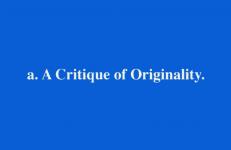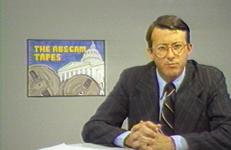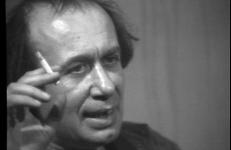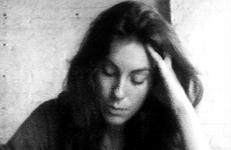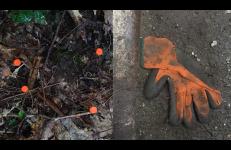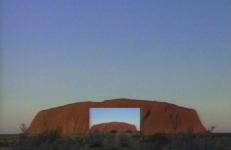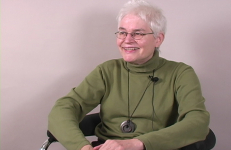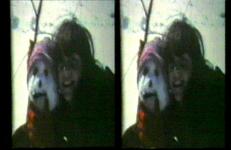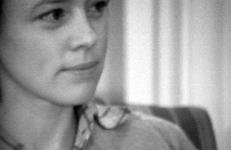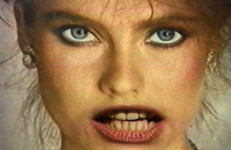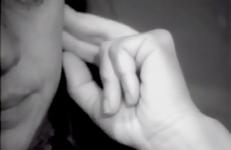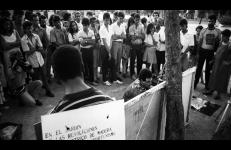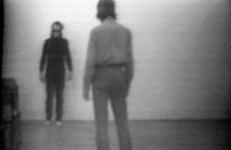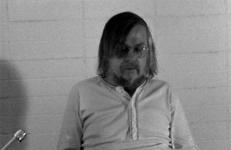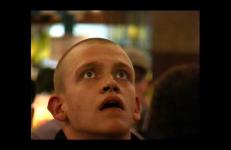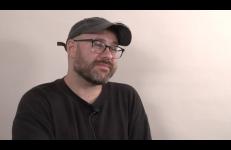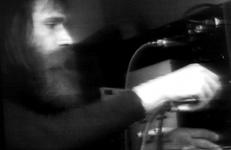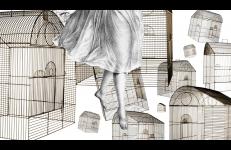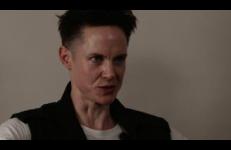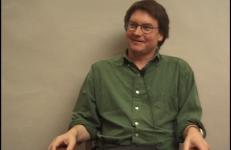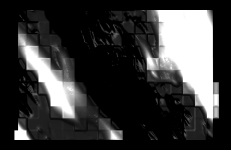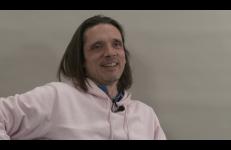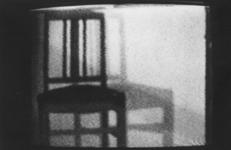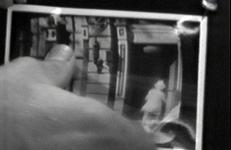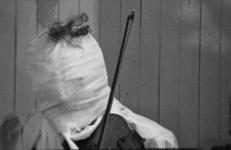6^ is part of the Pop Manifestos series, a five video project realized in collaboration with Cokes' former students Seth Price and Damian Kulash, and originally conceived as part of a series for the conceptual band SWIPE.
Conceptual Art
Abscam (Framed) frames the FBI sting operation known as "Abscam" by mixing FBI surveillance footage of Congressman Michael "Ozzie" Meyers with footage shot by Lord at the Motel where the original sting occurred—in the process, inserting the artist into this moment in history.
Vito Acconci (b. 1940) is known as a conceptual designer, installation and performance artist. In the 1960s he embraced performance in order to "define my body in space, find a ground for myself, an alternate ground from the page ground I had as a poet." Acconci’s early performances, including Claim (1971) and Seedbed (1972), were extremely controversial, transgressing assumed boundaries between public and private space and between audience and performer.
Affected and/or Effected begins with a close-up of a girl resting her head on her hand, reading. On the overlapping track a male voice states “affected,"—followed by a female voice that responds “and/or effected….” This pattern of dividing words in half and presenting them in alternating male and female voices continues throughout the video. While what is seen is separated from what is heard, the boundaries between the audio and video portions of the piece are complicated by other sounds. The statement of intent is spoken: "An artist may construct an art.
For over two years we made it our business to document abandoned working gloves on the streets of NYC. The feelings and thoughts that surrounded this activity connected to the ways his family relates to Gregor Samsa as a cockroach, or whatever Franz Kafka intended him to be in The Metamorphosis after his transformation from a productive citizen to a useless insect. When Gregor can't grant them a comfortable life-style any longer, his family starts to resent and hate the once loved and respected provider, finds him disgusting.
A huge isolated rock in the midst of the desert in Australia: Ayers Rock. I produced two contrasting films around this rock: Moments at the Rock was shot with an amateur video camera, amazing color changes, and time-lapsed compressed sequences; A Rock in the Light, edited with the music of Haruyuki Suzuki, is more visually structured, following the passing of time from the sunrise to the sunset.
--Takahiko iimura
"Takahiko iimura's Air's Rock is an ultimate landscape film."
--Katsuhiro Yamagucki, artist and author
The word-based art and performances crafted by world-renowned artist Alison Knowles (b.1933) are central to the 1960s international Fluxus movement and its enduring legacy. Describing her experience as a student at Pratt University in the 1950s where she learned from Richard Lindner and Adolf Gottlieb, Knowles recalls her transition from Abstract Expressionist painting to the chance operations initiated by John Cage and Bertolt Brecht.
The innocence of creating a mirror, only to repeatedly crush it underfoot.
This title is also available on Ximena Cuevas: Dormimundo Vol. 1 (Sleepworld Vol. 1), Ximena Cuevas: El Mundo del Silencio (The Silent World), and Half-Lies: The Videoworks of Ximena Cuevas.
Laurie Anderson (b. 1947) began her career as a gallery artist specializing in photography, before moving to critical work as a writer for Art News and Art in America. She later returned to the art world, making groundbreaking multimedia performance art. Her most widely known work dates back to the early-to-mid-’80s, and is marked by an innovative use of technology in blending media-based and staged performance.
Androgina is a stand-alone work excerpted from Generic Video Art. "Generics" is the name applied to no-name foods and household items that began appearing in grocery stores during the recession of the 1970s. When novels were added to the collection of genre products, entitled "Western," "Romance," "Adventure," etc., it was from this phenomenon that the initial idea for Generic Video Art arose.
Through her performances and videotapes, Eleanor Antin (b. 1935) creates characters (King, Ballerina, Black Movie Star, and Nurse) while spinning tales that blur fiction and history. She avoids good taste and flaunts concealed intentions, forcing one to stretch all possible associations to the breaking point.
“I believe interesting art has always been conceptual... that it appeals to the mind. That does not mean that it cannot seduce and attract through the eye,” Antin says in this interview with Nancy Bowen.
This documentary explores the groundbreaking street performances of Cuban artist JuanSí González during the 1980s. A pioneer of relational aesthetic practice in Cuba, González transformed public spaces in Havana into laboratories for edgy exchanges between artists and the public and created numerous works that threw art's role in a socialist society into question. His experiments provoked surprise from his peers and suspicion from state authorities. Twenty years later, the artist sat down to reflect on the relevance of those performances for the development of Cuban contemporary art.
As a document of an early performance, this video details the process of orientating the body and self in space, providing a physical metaphor for the process of adjusting oneself in society.
"Blindfolded, ears plugged: our goal is to sense each other’s movement and bearing, to attempt to assume the same movement and bearing. An off-screen voice, heard only by the audience, gives directions that would help us attain our goal."
—Vito Acconci, "Concentration-Container-Assimilation," Avalanche 6 (Fall 1972)
"One of Baldessari’s most ambitious and risky efforts. Seated and holding a sheaf of papers, he proceeds to sing each of Sol LeWitt’s 35 conceptual statements to a different pop tune, after the model of Ella Fitzgerald Sings Cole Porter. What initially presents itself as humorous gradually becomes a struggle to convey Lewitt’s statements through this arbitrary means."
—Helene Winer, “Scenarios/Documents/Images,” Art in America 61 (March 1973)
Berlin Zoo is a video loop set in the train station and terminal interface of the same name. Several bystanders were captured by the artist’s camera as they are gradually overcome by a general state of disbelief – of shock and awe even – while staring upwards at the arrivals and departures timetables. This gallery of grimaces is intertwined with an eerie soundtrack of wind blowing and occasional squawks of birds. Berlin Zoo could be classified as a fake documentary on the contemporary wildlife of a metropolis, an exercise in modern day ornithology.
Zach Blas is an artist, writer, and filmmaker whose practice spans technical investigation, research, conceptualism, performance, and science fiction. Currently a Lecturer in the Department of Visual Cultures at Goldsmiths, University of London, Blas has exhibited internationally, including at the Walker Art Center, Gwangju Biennale, Los Angeles County Museum of Art, and Whitechapel Gallery.
In this video the artist states that a public work demonstrates what qualifies as art within his conception. Like Beached, it was also shot in a marshy area near the sea and in sequences separated by dissolves. One sees five different actions related to Broken Off. The artist breaks a tree branch, scrapes and kicks the ground with his foot, snaps a stick in two on a fence, scrapes a stone with his fingernail. At the end he pulls the line plug from the video, drawing attention to the mechanics of the medium.
If asked to say what this work is about in one word, the answer — which is woven into the electronic musique concrète soundtrack — would be a Joycean one: it’s a “collideorscape.” The imagery is a return to materials Rankus dealt with as a young man in the video Naked Doom (1983). He has recycled imagery such as cages, a toy robot, and brain convolutions; newer motifs include a winged ballerina, Victorian corsets, and alchemical vessels containing birds.
In conversation with David Getsy — an art historian focusing on queer and transgender methodologies in sculpture theory and performance history — Cassils discusses their monumental performance artworks and inspirations.
Matthew Coolidge is a founder and director of The Center for Land Use Interpretation (CLUI), an organization dedicated to raising awareness about how land is apportioned, used and perceived by its inhabitants. Through exhibitions, publications, and guided tours, Coolidge and the CLUI seek to foster and encourage a heightened sense of awareness of natural surroundings. In this interview, Coolidge defines a ‘land art spillover effect,’ in which the perceived significance of the landscape seems to increase the closer people get to a piece of environmental art.
This is the crude and unnatural state of civilization, an image not yet processed or refined that hides and displays in its intermittence all the crude violence of the anthropocenic industry. The raw and fossil image of the Capitalocene. Part of the Hauntology series.
Turner Prize winning conceptual artist Jeremy Deller works across many different mediums, creating highly political and frequently collaborative works. Defying conventionality, Deller often exhibits outside of traditional gallery spaces, such as his 1993 twist on artist open studios, Open Bedroom, a secret exhibition in Deller’s family home while his parents were on holiday.
A collection of early conceptually oriented videos which were produced in Tokyo in the early 1970s using words along with images, except for the first two flicker-effect pieces: A Chair (1970) and Blinking (1970).
Time Tunnel (1971) is an attempt at time travel in a very conceptual sense.
Man and Woman (1971) shows full body images of a naked man and woman shot from above without movement. They are shown alone as well as together, one over (or under) the other, symbolizing words at the same time as their positions.
Baldessari has Ed Henderson examine obscure movie stills and attempt to reconstruct the films’ narratives. By removing the image from its ordinary context—in this instance the chronological flow of film time—the process of interpretation itself and the contextual meaning carried by images is examined. During these interpretative exercises, Ed Henderson urges the viewer to question where the meaning of an image lies: within the image itself or within the spectators’ reading of the image.
This title was in the original Castelli-Sonnabend video art collection.
In a radical action like Nam June Paik destroying a violin, and rolling up in bandages the bodies of the players in in a concert by Yoko Ono, the international avant-garde group Fluxus changed not only art, but the concept of it.




